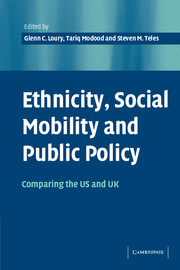Book contents
- Frontmatter
- Contents
- List of figures
- List of tables
- List of contributors
- Acknowledgements
- Introduction
- Part I Historical overviews
- Part II Informal social networks
- Part III Formal structures
- 9 Educational progress for African-Americans and Latinos in the United States from the 1950s to the 1990s: the interaction of ancestry and class
- 10 The educational attainments of ethnic minorities in Britain
- 11 Why America's black–white school achievement gap persists
- 12 Networks and niches: the continuing significance of ethnic connections
- 13 Nonwhite origins, Anglo destinations: immigrants in the USA and Britain
- 14 Social mobility of ethnic minorities
- 15 Ethnic minorities, employment, self-employment, and social mobility in postwar Britain
- Part IV Political institutions and processes
- Part V Normative analysis
- Author index
- Subject index
- References
11 - Why America's black–white school achievement gap persists
Published online by Cambridge University Press: 22 September 2009
- Frontmatter
- Contents
- List of figures
- List of tables
- List of contributors
- Acknowledgements
- Introduction
- Part I Historical overviews
- Part II Informal social networks
- Part III Formal structures
- 9 Educational progress for African-Americans and Latinos in the United States from the 1950s to the 1990s: the interaction of ancestry and class
- 10 The educational attainments of ethnic minorities in Britain
- 11 Why America's black–white school achievement gap persists
- 12 Networks and niches: the continuing significance of ethnic connections
- 13 Nonwhite origins, Anglo destinations: immigrants in the USA and Britain
- 14 Social mobility of ethnic minorities
- 15 Ethnic minorities, employment, self-employment, and social mobility in postwar Britain
- Part IV Political institutions and processes
- Part V Normative analysis
- Author index
- Subject index
- References
Summary
Beginning when Europeans first shipped Africans across the Atlantic Ocean to be slaves in America, blacks and whites have worked together building a nation. However, only in the past several decades has the possibility been seriously considered that blacks should be equal-status partners in this nation-building endeavor. Even after the abolition of slavery in 1863, white supremacists conspired for generations to discourage and obstruct black strivings for respect and social mobility. In the view of white supremacists, blacks were an inferior breed, preordained to serve white society as menial, uneducated, subsistence workers. The Jim Crow system of racial separatism and its ideology of white supremacy dominated the American South and influenced the North as well, beyond the middle of the twentieth century. Its influence still survives. In virtually every domain of social, political, and economic life, the nation today is living with the consequences of white supremacy.
This chapter considers why well over a century past emancipation and fifty years after the Supreme Court of the United States outlawed forced racial segregation in schools, there continues to be test-score disparity between school-aged African-American and European-American children. The topic is important for two reasons. One is that test-score disparities among children turn into other forms of disparity among adults. For example, studies in the 1980s and 1990s found that test-score disparities predicted at least half of the hourly earnings gap between black and white young adult workers (e.g., Johnson and Neal 1998).
- Type
- Chapter
- Information
- Ethnicity, Social Mobility, and Public PolicyComparing the USA and UK, pp. 309 - 341Publisher: Cambridge University PressPrint publication year: 2005
References
- 5
- Cited by



